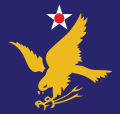513th Electronic Warfare Squadron  | |
|---|---|
 53d Wing F-35A Lightning II at Nellis AFB | |
| Active | 1942–1965; 1986–1997; 2010–present |
| Country | |
| Branch | |
| Role | Electronic Warfare |
| Part of | Air Combat Command |
| Garrison/HQ | Eglin Air Force Base |
| Engagements | Mediterranean Theater of Operations |
| Decorations | Distinguished Unit Citation Air Force Outstanding Unit Award Air Force Organizational Excellence Award |
| Insignia | |
| 513th Electronic Warfare Squadron emblem [a] [1] |  |
| 513th Test Squadron emblem [b] [2] |  |
| 513th Bombardment Squadron emblem [c] [3] |  |
The 513th Electronic Warfare Squadron is a United States Air Force unit assigned to the 350th Spectrum Warfare Wing at Eglin Air Force Base, Florida.
Contents
- Mission
- History
- World War II
- Weather reconnaissance
- Strategic Air Command
- Operational test unit
- Electronic warfare for F-35
- Lineage
- Assignments
- Stations
- Aircraft
- Awards and campaigns
- See also
- References
- Notes
- Bibliography
The squadron was formed as the 513th Bombardment Squadron in the Middle East in 1942 to reinforce the Royal Air Force in North Africa with personnel and aircraft diverted from delivery to the China Burma India Theater. The squadron moved forward, eventually being stationed in Italy, where it participated in the strategic bombing campaign against Germany, and was awarded three Distinguished Unit Citations for its combat actions. Following V-E Day, the squadron returned to the United States, where it converted to Boeing B-29 Superfortress bombers, but was inactivated in March 1946.
The squadron was redesignated the 513th Reconnaissance Squadron and activated in 1947 as a weather reconnaissance unit. Except for a brief period of inactivation in the winter of 1948–1949, it continued the reconnaissance mission until February 1951, when it was inactivated and its assets transferred to another squadron.
The squadron returned to the bombardment mission later that year, and upgraded to jet Boeing B-47 Stratojet bombers in 1954. It continued to fly the Stratojet until they were phased out of the Air Force inventory, and the squadron was inactivated in 1965. It was redesignated the 513th Test Squadron and activated in 1986, serving in that role until inactivating in 1997. It was activated in its most recent role in 2010.





